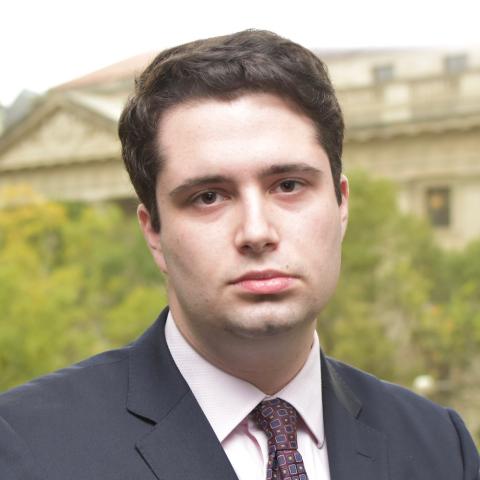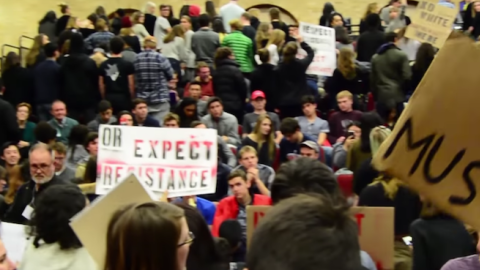On Thursday, hundreds of students at Middlebury College shouted down political scientist Charles Murray, forcing him to deliver his remarks in a private room via a live web stream.
While he delivered his remarks, student troublemakers pulled the building's fire alarm multiple times. Shouting could be heard in the background throughout the live-streamed lecture and subsequent conversation with Political Science Professor Allison Stanger.
When Stanger and Murray left the building, things turned violent, the Addison County Independent reports:
As Stanger, Murray and a college administrator left McCullough Student Center last evening following the event, they were “physically and violently confronted by a group of protestors,” according to Bill Burger, the college’s vice president for communications and marketing.
Burger said college public safety officers managed to get Stanger and Murray into the administrator’s car.
“The protestors then violently set upon the car, rocking it, pounding on it, jumping on and try to prevent it from leaving campus,” he said. “At one point a large traffic sign was thrown in front of the car. Public Safety officers were able, finally, to clear the way to allow the vehicle to leave campus.
“During this confrontation outside McCullough, one of the demonstrators pulled Prof. Stanger’s hair and twisted her neck,” Burger continued. “She was attended to at Porter Hospital later and (on Friday) is wearing a neck brace.”
On Tuesday, we wrote about the brewing storm at Middlebury, commending administrators and faculty for supporting Murray's visit in the fact of tremendous pressure. We've come to be pretty pessimistic about campus discourse, but this is a far worse outcome than we anticipated. Students responsible for physical violence should be punished with suspension, expulsion, and the worst offenders should be charged in court.
Middlebury administrators and others are trying to frame this as simply about respect for free speech and open discourse. But this is about more than the narrow issue of free speech. Academics and administrators need to take a hard look at the ideology many of them have been directly and passively incubating on campuses.
Before Murray's lecture, over 500 alumni signed a letter which claimed that Murray's visit sends "a message to every woman, every person of color, every first-generation student, every poor and working-class person, every disabled person, and every queer person that not only their acceptance to and presence at Middlebury, but also their safety, their agency, their humanity, and even their very right to exist are all up for 'debate.'" The letter closes by asserting that Murray's presence on campus "directly endangers members of the community."
If Murray genuinely were directly endangering the Middlebury community and threatening the "existence" of its members, he probably shouldn't be allowed anywhere near the State of Vermont. But, of course, Murray isn't actually the kind of threat these students imagine. As their letter makes clear, and echoing what Middlebury Sociology Professor Michael Sheridan freely admitted to a reporter the other day, few if any of the protestors have ever read Murray's books. If they had, they would know that he's been grossly mischaracterized. In The Bell Curve, Murray and his coauthor clearly stated that environmental factors are at play—i.e. that socioeconomic and other pressures have some effect on IQ and thus on later success. And Coming Apart, the relatively uncontroversial and well-reviewed book Murray was invited to Middlebury to speak about, doesn't talk about race at all. Meanwhile, the idea that Murray is anti-queer is especially odd: Murray was publicly pushing Republicans to support marriage equality before Hillary Clinton had flip-flopped on the issue.
If students (and especially professors, who really ought to know better) want to criticize an author, they should read what he's written first. That so many clearly did not speaks to the deteriorating academic rigor of colleges today. If college students are not internalizing the need to engage primary sources, what exactly are they learning in their undergraduate years?
The ideology that has taken hold of academia is intellectually lazy and thus leads to sloppy, emotion-driven conclusions. Murray may be deeply unsettling and even terrifying to some. We'll take students at their word about such subjective matters. But, objectively, a Charles Murray lecture does not pose a literal threat to anyone's existence. That is lunacy.
It's also genuinely scary; it's this line of thought that led some hot-headed protestors to justify physically assaulting Murray and Stanger. This is why it won't be enough for professors and administrators merely to defend open discourse in vague, principled terms. They need to engage students (and clueless, supportive faculty) in a debate about deeper substance.
There are many ironies contained in this story. Protestors shouting fire falsely (with the help of the alarm) in a crowded building is one of them. Another is that an effort to silence Murray has resulted in raising his profile and basically guaranteeing that many thousands more people will now watch his lecture and perhaps even buy his books. But the greatest irony of the whole mess is that the people who said Charles Murray was directly threatening their safety ended up participating in a demonstration that resulted in the physical assault of two distinguished scholars, one of whom went to the emergency room.
And the students are the ones who say they need a safe space?

















